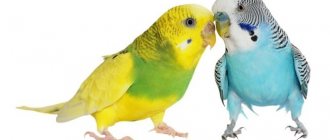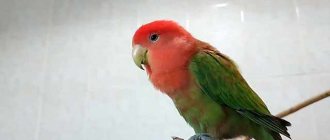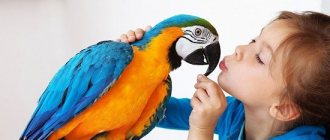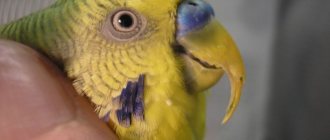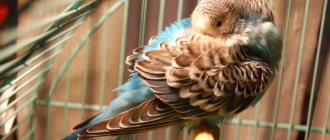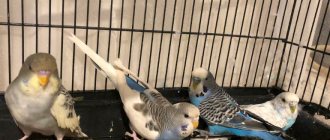Causes
Both reasons seem to me to be equally common:
- drafts (possibly ventilation or the cage is next to the window);
- swimming at low indoor temperatures (or in cold water).
Drafts are extremely undesirable for wavy fish, as is swimming in a cold room. It is easier to prevent this from happening than to treat the bird later.
If the bird does get sick, it is necessary to correctly recognize the disease. Because treating a bird for a disease that it does not have is a bad idea.
Keep a first aid kit for your parrot on hand.
The first aid kit for a parrot, which every owner should have on hand, includes the following items:
- Doctors' phone numbers
- Addresses of the nearest veterinary clinics and pharmacies, as well as laboratories where animals can be tested
- Ballpoint pen and paper for quickly writing down doctor's recommendations
- Antiseptic wipes
- Band-Aid
- Tweezers
- Cotton wool or cotton swabs
- Cotton swabs for cleaning wounds or using as a splint for fractures
- Hydrogen peroxide
- Activated carbon
- Scissors
- A small towel for possible fixation of the patient
- Elastic bandage
- Salt universal applicator for heating poultry or heating pad
- Tea spoon
It makes no sense to list a list of medications, since they depend on the parrot’s disease itself and the treatment prescribed by the doctor.
Symptoms
To more accurately determine a cold, it is necessary to detect several symptoms in the parrot. What symptoms may appear:
- passivity, lethargy, apathy; the bird is inactive, rarely chirps, and hardly moves around the cage;
- the parrot often sneezes with wet discharge on the beak and wax;
- the mucous membrane of the nose and mouth is inflamed and red, because of this the bird may often swallow, regurgitate food and breathe heavily (easy to detect by the movement of the tail in time with breathing);
- the parrot often scratches the wax with its paws or on objects;
- in some cases the parrot refuses to eat and drink;
- possible trembling.
How does the virus become infected?
The virus can be infected in different ways: airborne droplets, contact (through shared towels, cutlery, through kissing), sexual intercourse, self-expression (when the virus from ulcers enters healthy mucous membranes and infects them). You can become infected through a blood transfusion and a child can receive the virus from the mother in utero. The incubation period (from the moment of contact until the first signs appear) is 2-14 days. A person becomes contagious as soon as sores appear on the lip, and is contagious to others until the scabs fall off .
Photo: One of the most common ways of transmitting herpes is contact.
Treatment
Now let's talk about treatment.
First of all, make sure that the room temperature corresponds to normal conditions and does not fall below 22 degrees.
If there are several birds in a cage, the sick bird should be placed in a separate cage from the healthy ones. If all the birds are sick or you have only one parrot, then there is no need to remove them.
Lamp
A sick bird needs to turn on an incandescent lamp. There is no need to use energy-saving, diode or other lamps. The lamp power should be 60 watts. The incandescent lamp must be installed above the cage at a distance of 35-45 cm. If the lamp is more powerful, then it must be installed higher. One half of the cage is covered with thick dark cloth.
When the parrot warms itself, it will go into the shade. The lamp must be turned off and turned on after 2-3 hours. If the wavy does not want to warm up, turn off the lamp. This procedure must be repeated 3-5 times a day.
One heating period should not exceed one hour. In just one day, a parrot can bask for 3-5 hours in total. Overheating is highly undesirable.
Medicines
During a cold, a solution of chamomile is poured into the drinking bowl. Change the solution 2-3 times a day.
Honey and lemon. Budgerigars
You can also add honey and (or) lemon juice to the chamomile solution. Dosage: 3 drops of honey and lemon juice per 50 ml.
Inhalations
For severe colds with frequent coughing, profuse nasal discharge and constant sneezing, it is necessary to perform steam inhalation procedures.
Menthol oil
For inhalation you can use:
- menthol oil: 0.5 ml per 100 ml of boiling water;
- eucalyptus oil: 0.5 ml per 100 ml of boiling water;
- chamomile decoction: 1 tbsp. chamomile to 250 ml of boiling water;
- Eucalyptus decoction: 1 tbsp. chamomile per 300 ml of boiling water;
- sage decoction: 1 tbsp. chamomile to 300 ml of boiling water.
The container with the solution is placed next to the cage. I cover the cage and container with a towel. During the procedure, watch your pet: if it is noticeable that he is breathing heavily, spreading his wings, closing his eyes, then reduce the procedure time and open the fabric slightly.
Menthol oil
Steam inhalations are carried out in a course of 1 or 2 times a day for 15-25 minutes for 4-5 days.
In case of severe shortness of breath, sniffling or whistling, inhalation is prohibited! Possible pulmonary edema.
Parrot has a cold
Colds in budgies and other parrots are unfortunately a common problem. But the point is not that the parrot, for example, has a weak immune system or the climate is not suitable for it, but that the conditions of detention are incorrect and the owner is inexperienced.
In fact, birds are reliably protected from temperature changes thanks to their plumage, which acts as a blanket. Depending on changes in air temperature, the parrot either presses its feathers to its body or fluffs them up, creating comfortable conditions for itself. But such “tuning” takes time. In natural habitats, the temperature changes gradually: from season to season and from day to night. It does not happen that it changes abruptly, within a few seconds. Thus, parrots have time to adapt to environmental changes and meet them fully armed. But when kept in captivity, sharp changes in t occur, for example, due to strong drafts and air conditioning.
Drafts are the main cause of colds in pet parrots. Imagine the situation: a pet is warm and comfortable in its cage, but suddenly the windows open and a draft is created. The parrot is affected by a sharp change in temperature, which he did not expect and, accordingly, did not have time to prepare for it, and cold air passes through his practically unprotected body. The result is that the parrot caught a cold.
Remember how often we catch a cold in winter, even though we are wearing warm jackets and hats? The parrot does not have such protection; its body experiences stress and responds to it with a cold. It only takes one draft for a bird to get sick. But in some apartments, ventilation (read: drafts) is the daily norm. Don't forget about air conditioners, thanks to which warm air can change to cold (and back) at the speed of light.
Improper transportation also causes colds. There are many cases where a parrot, bought at a poultry market in the cold season, died barely reaching its new home. The reason is a sudden change in temperature, hypothermia and severe stress. The parrot was taken from a warm apartment, brought to the market, where it was waiting for new owners, and then taken to a new home. Temperature changes are combined with severe stress, and the sensitive body cannot cope with the load. At best, the bird will catch a cold, at worst, it will die. Therefore, it is recommended to purchase parrots from conscientious breeders who keep them in the correct conditions, and transport them in a heated box, a warm car, or, in extreme cases, in the bosom.
Colds in parrots: symptoms
It is very important to promptly detect signs of a cold in a parrot and take action, otherwise his life will be in danger.
A parrot that has a cold becomes lethargic, fluffs up its feathers, breathes heavily, sneezes frequently, trembles, refuses to eat, and discharge appears from its nose.
Symptoms may be isolated or appear all together. You should not wait for the disease to gain full strength. If you think something is wrong with your parrot, contact an ornithologist immediately. When it comes to health, it's better to be safe than sorry.
Preventing colds in parrots
Prevention of colds in parrots is, first of all, proper maintenance: absence of drafts, distance of the cage from air conditioners and household appliances, high-quality balanced nutrition, fresh drinking water at room temperature, absence of stress, proper transportation.
To prevent your parrot from catching a cold, you need to support its immunity, monitor its health and not create conditions for hypothermia or overheating.
The parrot caught a cold: what to do?
If you notice signs of illness in your parrot, you need to contact a veterinarian as soon as possible. Any delay here is dangerous, since symptoms in birds appear only when there really is a problem. A parrot cannot “get a little sick” and recover on its own. Without timely treatment, a cold will cause complications and will most likely lead to death.
To treat severe colds, parrots are prescribed antibiotics and inhalations. There is no point in trying to deal with the problem on your own, without the help of a specialist. If only because the signs of a cold may actually indicate another disease, for example, an infection. The symptoms of some diseases are very similar. Only a specialist can determine the exact cause and prescribe treatment.
To protect your pet's health, always adhere to the conditions of detention and keep the ornithologist's contact information at hand. Take a responsible approach to caring for your charges, and then they won’t be afraid of any cold!
Home prevention methods
Preventing colds should begin in the summer. The condition of the body depends on nutrition and the intake of vitamins. A healthy lifestyle and balanced diet will help support your immune system. To do this, you need to include vegetables and fruits, fermented milk products, and a sufficient amount of lean meat and fish in your menu.
Traditional methods of preventing ARVI recommend medicinal plants and products with an immunostimulating effect. These include:
- ginger;
- garlic;
- onion;
- lemon;
- mint;
- echinacea;
- birch mushroom.
An effective method of preventing colds is staying hydrated. An adult needs 1.5-2 liters of clean water per day. This volume supports the functioning of the kidneys, helps them quickly filter the blood and remove toxic substances, viruses and metabolic products.
Why do cold sores appear on the lips?
Those who suffer from herpes have noticed that exacerbations begin along with ARVI. Herpes occurs when immunity decreases, the protective forces of which are used to suppress ARVI. Colds on the lips also appear when the body’s defenses are weakened: with chronic fatigue, lack of sleep, frequent stress, poor diet, alcohol abuse and active smoking, in women at the beginning of pregnancy and in the first 5-7 days after childbirth.
Photo: Colds on the lips can only appear if the immune system is weakened
How can you tell if your parrot is sick?
If birds could speak, then understanding this issue would be much easier. Sometimes owners pay attention only to too obvious problems in behavior, for example, the parrot is trembling and sneezing endlessly.
In fact, a person must respond to various signals in a timely manner:
- Lack of appetite;
- Lethargic behavior;
- Labored breathing;
- External changes in the beak (color, delamination and peeling);
- Feather loss;
- Blurred vision;
- Problems with the gastrointestinal tract (liquid in excrement, etc.);
- Runny nose;
- Scabies;
- Long sleep on two legs;
- Lameness.
If you find at least one of the above symptoms, you should not self-medicate and look for help on forums, since only an experienced ornithologist in Nizhny Novgorod will be able to accurately diagnose. The veterinarian will conduct a thorough examination of the patient using auscultation, palpation, and temperature measurements. If an accurate diagnosis cannot be established, then the ornithologist from the emergency veterinary care will prescribe tests and other necessary diagnostic methods.
How does herpes manifest?
In medicine, it is customary to distinguish 5 stages of the development of herpes simplex: 1. The first stage occurs when blisters appear. It manifests itself as burning and itching in the lip area, and its swelling. 2. The second stage begins with the appearance of bubbles. At first small, they grow and fill with clear liquid. After a couple of days the liquid becomes cloudy. 3. The third stage of the disease is characterized by rupture of the vesicles. In place of the burst blisters, ulcers with swelling form. This stage is dangerous due to the development of complications. The person at this moment is very contagious. 4. In the fourth stage, the ulcers become covered with a dense crust. 5. At the fifth stage, the crusts dry out and fall off. The symptoms go away. The person becomes no longer contagious.
Daily routine and hardening
Colds and flu can be prevented with the help of hardening procedures, which begin in the summer. In childhood and untrained people, you can wipe with a damp towel, pour cool water over your feet, gradually lowering the temperature. Hardening helps improve thermoregulation; the body will not react to hypothermia with a cold.
But hardening procedures do not give an effect immediately and only when carried out regularly. If you stop dousing, after a few weeks the body will again become susceptible to disease.
To prevent colds, it is important to follow a daily routine and avoid stress. During sleep, the hormone melatonin is produced, which is involved in regulating the function and coordinated functioning of the nervous, endocrine and immune systems. An important condition is to go to bed before 23:00, do not watch TV before bed and do not use gadgets. Melatonin is produced only in complete darkness.


